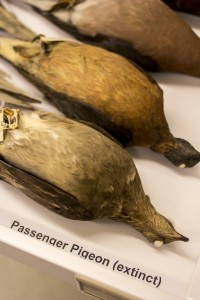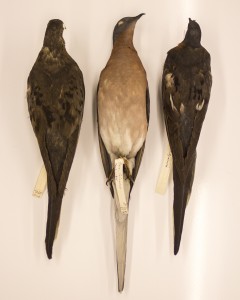When you think of bringing back a species that is extinct, you may picture a huge Woolly Mammoth or a giant Tyrannosaurus rex. But have you ever pictured bringing back a plump, dove-like bird, the Passenger Pigeon? It seems a highly unlikely candidate for the de-extinct research being conducted by Long Now Foundation’s Revive & Restore. This group of geneticists are working on what they call genetic rescue, to both save highly endangered species and bring back extinct species. But what role do museums play in the de-extinction of a species that died out in 1914?

Passenger Pigeon egg from the Tetrapod Collection © Hothem, 2016
Why Bring Back the Passenger Pigeon?
Imagine a sky darkened for hours because a cloud of birds are passing through a town on the way to their roosting spot. Though an amazing sight to behold these birds were actually quite damaging to the forests they used as a roost. Branches would break under the weight of nests and birds. Feces would cover the trees and ground and cause a rise in acidity in the soil. Scientists Ellsworth and McComb (2003) suggested that about 8% of the forests within the pigeons’ breeding area were damaged annually.
While all this sounds terrible for the forest, the birds were also aiding in the creation of a healthier forest. How? The damage they caused to the forest canopy, allowed more light to enter the forest. The feces they produced would actually add some nutrients to the forest floor creating nutrient rich soil. In addition, their main food source, various nuts from oaks and beeches, were able to spread throughout the Passenger Pigeon’s breeding range creating some of the various forest we walk through today.
Revive & Restore’s overall goal in de-extinction of the Passenger Pigeon is to fill the lost forest disturbance niche that the pigeon’s extinction caused. Researchers debate that by bringing back the pigeons the need for human managed forest fires or disruptions will be decreased. They hope to create more natural forest regeneration via the pigeon’s destructive behavior.

Tray with Passenger Pigeons ©Hothem, 2016
A Museum’s Role in De-Extinction
Museums, like vast libraries of natural history, hold the key for groups like Revive & Restore. Museum collections, such as the Tetrapod Collection here at OSU, are the final resting places for extinct species. Study skins hold the genetic material that researchers need to understand what genetic components are necessary to bring back or understand the evolution of a species. It is part of our mission to make sure that these species are understood not just in terms of location and date but also in terms of their genetic makeup or DNA. Using museum specimens for DNA sequencing of extinct species is not a new topic, in fact, it became popular in 1984 with examining dried quagga muscle tissue. Researchers then used this technique to confirm that the quagga, an extinct member of the horse family, really was as closely related to today’s horse as fossils suggested. Now researchers are looking at using Passenger Pigeon study skins to create a full genome of the species to better understand both its evolution and how to bring it back to today’s skies.
Be sure to check out the Tetrapod Collection’s campaign and help us purchase a new mobile cabinet for the extinct species in our collection. Our goal is to raise $5,500 and to educate people, about tetrapods throughout the month of October. Be sure to check out our videos, social media, blog and campaign page!

Passenger Pigeons ©Hothem, 2016
About the Author: Stephanie Malinich is collection manager of the OSU tetrapods at the Museum of Biological Diversity.
Literature cited:
ELLSWORTH, J. W. and McCOMB, B. C. (2003), Potential Effects of Passenger Pigeon Flocks on the Structure and Composition of Presettlement Forests of Eastern North America. Conservation Biology, 17: 1548–1558. doi:10.1111/j.1523-1739.2003.00230.x
 About the Author: Stephanie Malinich is collection manager of the OSU Tetrapods Collection.
About the Author: Stephanie Malinich is collection manager of the OSU Tetrapods Collection.






